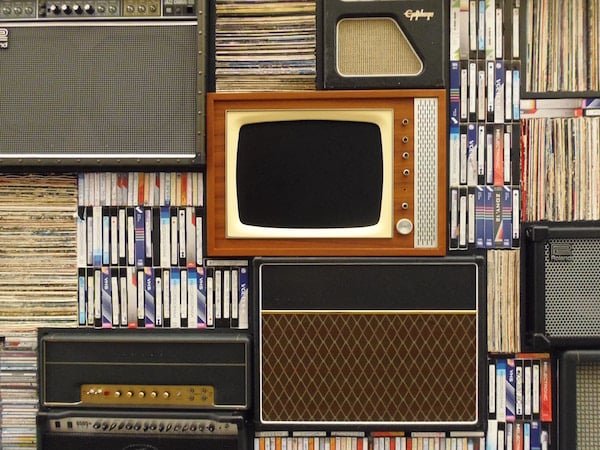Published on
Can Betamax Save Higher Education?

Why on Earth would someone want these tapes that couldn’t work with our VHS players and were clearly missing half of the wheel? Someone must be mad to buy one of these machines.
Interestingly, there’s a more important story than just two ugly hunks of plastic and which one would eventually have the honor of playing my cartoons. The victor would succeed in what is now dubbed the “Video Format Wars” and dominate the personal home entertainment market for the next 20 years, catapulting consumer media and many industries with it.
And, at the time, it wasn’t obvious that the VHS format would win over Betamax. In fact, quite the opposite.
In 1974 Betamax was released in the United States by Sony and represented their new novel technology and format for the emerging home video market.
Betamax was objectively and widely regarded as a superior format. Compared to VHS, it had a higher resolution (250 lines vs. 240 lines), superior sound, and a more stable image. The Betamax recorders were even of higher quality construction.
All rather important when choosing what to watch if you ask me.
Looks like we have a clear winner here, don’t we? Betamax is a better technology, and better technologies always win. Might as well hold the “Fast Forward” button and watch the squiggly lines all the way to the end of this story.
Except, that’s not what happened. Turns out that the US market found something to be more important: recording times.
Although cost was an important issue as well with VHS players being cheaper, Americans wanted longer tapes. Betamax had a recording time of only 60 minutes, while VHS had 120. Longer recording times meant that someone could fit an entire feature film or sports game on one tape. That’s right, getting the full football game on one tape was more important than the quality of the picture.
Although Betamax initially had 100% of the home player market in 1975, recording times eventually tipped the balance in favor of VHS. VHS won, and the rest is history.
You may be asking yourself: “Well, Grant, this talk of old electronics is all well and good, but how does this apply to saving higher education?”
The key takeaway from our sad story above is to come to the realization that only one thing matters: the customer.
Yes, even in education we have these things called customers. They have tastes and preferences, and make enrollment decisions based on those preferences.
The education customer (and specifically the working adult) is changing and has been telling us something for years. Although we don’t always hear their spoken complaints, they’ve spoken loudly with their dollars and feet. We’ve witnessed this unfortunate change of taste with the rise of higher education alternatives that completely circumvent college education like Coursera, Udacity or various boot camps. They have flourished in recent years while institutional enrollment numbers have floundered.
Unfortunately, as our poor friends at Sony learned, it doesn’t matter that higher education is objectively “better” than those alternative options. I don’t think anyone would argue that a nanodegree or boot camp certificate is comparable to four years of a liberal arts education. That’d be like comparing a Hanson concert to Pink Floyd. It’s not even in the same universe. Although these programs may provide some narrow benefits within a particular subject, they can’t compare holistically to university education.
It doesn’t matter though. Just like the fall of Betamax, it’s the consumer’s demand and prioritization of importance that means everything.
New America, a Washington-based nonprofit, conducted an interesting College Decisions survey in 2015, surveying students who planned to enroll in a two- or four-year college within the year or were in their first semester of college. The top reasons participants said they were going to pursue a degree were to improve economic opportunities (91 percent), to make more money (90 percent), and to get a good job (89 percent). This not only indicates a changing focus towards employment-directed programs as opposed to a broader intellectual pursuit, but also likely indicates the importance of urgency or speed at which the student can obtain their degree. Students in the past may have been willing to set aside a longer portion of their life for the greater pursuit of knowledge, but with the primary intent of seeking a better career or job, time would be of the essence.
The same study also inquired on what students were most concerned about when selecting a college. A staggering 88 percent responded the availability of financial aid, and specific college costs.
Customers are indeed speaking loudly, and they are telling us that accessibility, affordability, and marketability are paramount in choosing their educational path. It doesn’t take a magic ball to see why nimble educational alternatives have reaped the benefits at the expense of higher education. They’ve made their solutions fast, applicable to growing career segments and inexpensive. Why would a student dig up a 20-year-old high school transcript, assume a mountain of debt, or wait until class starts next fall, if they didn’t have to?
Recording times, not resolution.
With all entities serving customers, you must change to the demands of those customers to survive. It means customers or no customers, success or failure. Higher education has been slow to listen. We can all sit around and lament on the foolishness of these students to not see the apparent benefits of university education, but we’d go down with the Titanic accordingly for doing nothing. The circumstances are here, and they’re not going to change.
There is an answer though. We can address these changing consumer preferences and save higher education.
We can meet these emerging demands AND keep students on a path to higher education.
My edtech startup, OnlineDegree.com, is doing just that. We allow anyone to receive credit, up to their freshman year of college, completely tuition-free. Within minutes of registering, adults can begin taking a variety of free general education courses asynchronously online without the lengthy application process. We then work with a number of accredited universities where transfer credit can be awarded for successful completion of the courses. Students gain access to a wide range of courses and educational material, with pathways to receive credit at over 1,400 colleges throughout the US.
Our model doesn’t suggest bypassing traditional universities. Instead, our solution is to create a bridge that brings students back to a collegiate path regardless of their finances or busy schedules. We’re helping universities to remove significant accessibility barriers to help everyone take that first critical step towards a university education.
It’s innovation like this that focuses on higher education’s key problems of approachability and accessibility, rather than marginal improvement in its educational quality. U.S. institutions already offer world-class education—that’s not the problem. It’s innovative ideas to the former, and not the latter, that will have the greatest impact in bringing students back to a collegiate path.
Customers are screaming “Recording times!!” The question is, will we listen?
Author Perspective: Business


